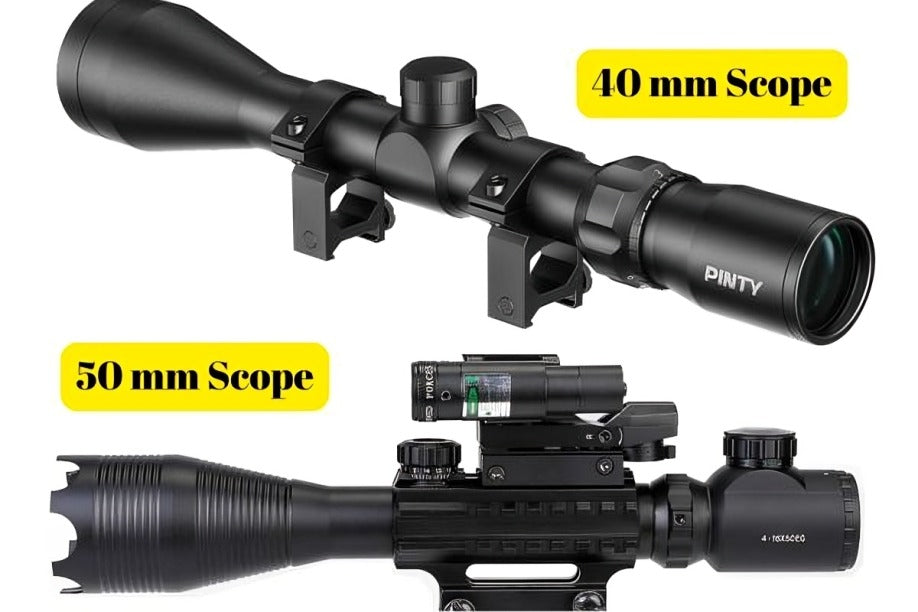If you do any kind of shooting beyond a few hundred yards, you need to you absolutely need to take a look at High Power Variable Scopes. At long range, no scope does what an HPVO can do: letting you see, range, and precisely engage targets at extended distances while simultaneously giving you usable reticle options and repeatable adjustments.
A lot of people think they are just bigger LPVOs, but it's not even close. Compared with an LPVO and/or an MPVO, an HPVO gives you far superior long-range resolution: you get finer adjustment granularity and more useful reticle subtensions at distance.
So, what exactly is an HPVO? What do you need to know if you intend to buy and use one?
What “HPVO” Stands For, and Why That Matters
The acronym “HPVO” stands for “High-Power Variable Optic”, which is sometimes pluralized as “High-Power Variable Optics”. Learning what “HPVO” means matters because that abbreviation describes three important HPVO design choices rolled into one name:
- High-power: the magnification band is centered on higher numbers (usually something like 6–24×, 8–32×, or 5–25×). That high magnification is what gives resolving power and precise aim at long distances.
- Variable: the magnification is adjustable across a useful range (not fixed). That variability lets you adapt focus and field-of-view for ranging, target ID, and engagement at varying distances.
- Optic: implies a riflescope intended for precision aiming (as opposed to a reflex/red-dot or spotting scope).
An HPVO is designed first for distance (resolution, fine turrets, parallax correction, reticles built for holdovers/ ranging), whereas an LPVO is designed first for close/medium engagements and quick target acquisition (low-end near-1×, wide field of view). Knowing the category narrows down which features you should prioritize for your mission.
Top 5 Key HPVO Features
1. High maximum magnification (and usable mid-range)
HPVOs have the highest zoom numbers in the high range (commonly 20–32× tops). The higher magnification enables identification and precision aiming at long ranges and smaller error angles, resulting in smaller group sizes on target.
A true HPVO gives comfortable resolution at distance without excessive image dimming.
2. Fine, repeatable elevation and windage adjustments (turrets)
The turrets on an HPVO are (typically) zeroable, exposed, or capped with small click values (e.g., 0.1 mrad or 0.25 MOA per click), positive detents, and often a zero-stop. As a precision shooter, you need predictable, tactile corrections for holdover and return-to-zero.
3. First focal plane (FFP) or well-thought-out reticle subtensions (SFP)
With an HPVO, you get a reticle whose subtensions remain accurate at any magnification (FFP), or an SFP reticle with clear markings at the primary magnification.
- FFP reticles scale with magnification, making mil/hash usage straightforward at any zoom, which is ideal for dynamic long shots.
-
If SFP, ensure the reticle is designed for the magnification you’ll use most.
4. High-quality glass and coatings (clarity and light transmission)
Another crucial HPVO feature is the high-quality glass the lenses are made of, and the low-dispersion elements used for coating. Lenses are multi-cated, and the optical designs are made to maximize resolution and minimize chromatic aberration.
4. Robust mechanical and parallax control
HPVOs feature solid tube construction, reliable erector systems, good eye relief, and adjustable parallax (side or objective).
A rock-steady optic holds point of aim between shots and under recoil. Parallax adjustment removes aiming errors at different distances, which is critical when dialing tight groups or switching targets at varying ranges.
Top 5 uses for an HPVO
1. Long-range precision shooting (600+ yards)
At long-range distances beyond 600 yards, where you need superior magnification to resolve target details and a reticle/turret system to make fine corrections, an HPVO is (realistically) the best choice.
- Most LPVOs usually top out at 6–8×, which is obviously not enough to clearly identify and precisely place shots at 600–1,000+ yards.
- MPVOs bridge the gap, but even the really good MPVOs usually lack the highest magnification and the fine turrets/reticle subtensions of dedicated HPVOs.
2. Target identification and engagement at extended distances
If you have a mounted setup for spotting and observing from a distance, you absolutely need an HPVO. The superior resolution and clarity are perfect for identifying distant targets, reading dark clothing patterns, or seeing target diagnostics.
Again, the HPVO’s higher magnification and better glass deliver the needed detail: LPVOs are optimized for close target acquisition and have narrower resolving power at long range.
3. PRS/NRL and precision rifle competitions
HPVOs are also excellent for precision rifle competitions that demand quick and accurate ranging, elevation calls, wind holds, and the ability to see small targets under time pressure.
With an HPVO, you get the magnification and subtension granularity that competitors rely on for making small corrections and reading mirage, especially on stages that require long shots. Many HPVOs are, in fact, built with specific competition features: tactical reticles, exposed turrets, and zero-stop.
4. Sniper / designated marksman roles (military, law enforcement)
There is a very practical reason why snipers use HPVOs: for an operational role (which is what being a sniper is), you need two things from a scope:
- precise engagement capability out to your scope’s maximum effective range
-
Robust mechanical reliability.
HPVOs work because they combine long reach, durable construction, and tactical adjustment features that LPVOs (tuned for CQB/vehicle work) don’t emphasize. Again, MPVOs may be a compromise, but the advantage of HPVOs is that they are purpose-built for such sustained long-range tasks.
5. Hunting in open country (mountain, prairie, high desert)
An HPVO is a top choice scope for hunting in open areas like mountains, prairies, and high deserts where magnification, light transmission, and precise holdovers are essential: it allows you to positively ID game at extreme ranges and place shots with precision.
- LPVOs are great in brush or timber but lack the reach when the animal and shooter are separated by big terrain.
- Also, they generally offer better optical clarity at range than most MPVOs designed as generalists.
Buying an HPVO: What to Look For
Before buying an HPVO, you need to be clear on what you will be primarily using the optic for. The key features to look for will differ depending on whether you are buying the HPVO for precision shooting, competitive use, or hunting.
General Shopping Checklist for HPVOs
- Magnification range: Pick a max range that matches your typical engagement distance (e.g., 6–24× or 8–32×, depending on how far you shoot).
- Reticle type: FFP is the reticle to go for if you want subtension utility at any magnification. For mil vs MOA, you choose based on your references and ballistic tools.
- Turrets: Choose between exposed turrets and capped turrets based on your shooting preferences. However, ensure that the turrets are repeatable and preferably have a zero-stop for rapid return to zero. Click value: 0.1 mrad (or 0.25 MOA) is common for precision.
- Check Parallax: The parallax must be adjustable to at least the ranges you’ll use. Keep in mind that side parallax is faster in the field.
- Optical clarity: Inspect the edge-to-edge sharpness, chromatic aberration, and light-gathering features. High-quality lenses are an extremely good sign.
- Durability and warranty. Ensure the scope parts are fully nitrogen/argon purged, shockproof, and fogproof. And it must have a warranty backed by the manufacturer.
- Mounting and weight: Especially for hunting, you don't want an HPVO that is too heavy. Ensure ring/mount compatibility and consider tradeoffs between glass performance and weight for rifle balance.
Buying the Best HPVO for precision shooting
When buying an HPVO for bench, PRS practice, or long-range drills, look for the following essential features:
- Higher maximum magnification (e.g., 8–32× or 6–24×), FFP reticle in mils if you use mil-based ballistic solutions, and fully exposed tactical turrets with a zero-stop.
- Exceptional turret repeatability (<0.1 mrad shift after long travel), low chromatic aberration, and parallax down to 10–25 m if you practice close targets.
- Precision work cares more about repeatability and fine adjustments than weight or having 1× capability.
Buying an HPVO for competitive use (PRS/NRL)
For competitive use, choose an HPVO with fast, repeatable exposed turrets, quick mag ring lock or low-resistance zoom ring, clear mil-based reticle with hashmarks for rapid elevation/wind holds, and a light but rigid chassis.
Also look for quick, positive turret detents, easy-to-read turrets, and reticle illumination options (subtle), and proven field reliability. Consider quick-detach (QD) mount compatibility if your match rules allow.
Competitions are a balance of speed and precision. These features ensure the optic lets you call, correct, and re-engage rapidly without losing zero.
Buying an HPVO for Hunting
When buying an HPVO for hunting, go for a magnification band that’s usable in the field (e.g., 4–20× or 5–25×): you may want a slightly lower minimum so you can find and track animals quickly. An FFP or an SFP reticle tuned to your chosen magnification, and excellent light transmission coatings.
The weight must be reasonable for a carry rifle, fast focus eyepiece, parallax adjustable to typical hunting ranges, and a reticle that supports dope/holdovers for your cartridge. Good anti-reflective coatings and low-light performance are critical for dawn/dusk shots.
Final notes and practical tips
Match the optic to the mission, not the marketing. Don’t buy the highest magnification because it sounds impressive, pick what your shooting distances and conditions demand.
- Try before you buy if possible. Rent, borrow, or shoot with a friend’s HPVO to test reticle feel, turret ergonomics, and clarity.
- Consider the entire system. Magnification is only one part: rings/mounts, rifle stability, ammo consistency, and a spotter or ballistic calculator all make the HPVO perform to its potential.
-
Budget wisely. A good HPVO is an investment; cheap glass will frustrate you at distance. Prioritize optical clarity, turret quality, and a trustworthy reticle over gimmicks.
A good HPVO is the long-range shooter’s workhorse because it does everything: see farther, measure finer, and deliver repeatable corrections when the target has room to miss.
If your typical engagement pushes beyond the sweet spot of an LPVO, moving up to a properly chosen HPVO will pay off in confidence and hits on the steel (or the game). Want me to recommend specific magnification bands and reticle choices for a particular caliber or range bracket you shoot?












